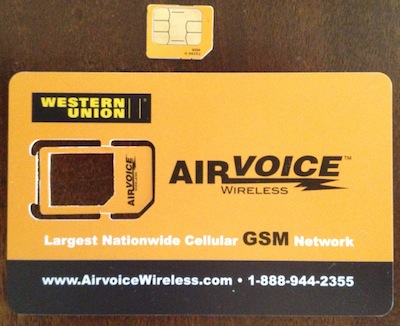Trimming the Phone Bill, Part 2
If you haven’t read part 1 yet, then you can see it here.
…Continuing on…
GoPhone prepaid wireless service was saving us a lot of money and we were happy with that for several months. However, nothing is sacred on our budget, and when I was looking over numbers a month ago I was convinced that we could save even more money without sacrificing any change in lifestyle.
I began looking for alternatives and was intrigued when I read a blog post on mrmoneymustache.com. Mr. MM goes into considerable detail so I will provide a synopsis of sorts. By switching from AT&T’s prepaid GoPhone service to Airvoice Wireless we could get a comparable level of service for only $10/mo per phone.

Airvoice is one of dozens of MVNOs, Mobile Virtual Network Operator. You can think of an MVNO as a reseller who buys network coverage and airtime from AT&T and then sells it in different packages to customers. Of course there are MVNOs that do the same thing for the Verizon network. In order to switch from GoPhone to Airvoice we had to do a few things.
1.) Purchase new SIM cards
While it may be possible to switch over to the AirVoice network and retain your original AT&T sim card, Airvoice cards can be found pretty cheaply ($5) online. There are several different sizes available nowadays thanks to the smartphone race for thinner devices. Our
iPhone 4S phones required micro sim cards.
2.) (Optionally) Port Your Phone Number
Airvoice Wireless makes it easy to keep your phone number. Just fill out the form on their website and within a day or two your new SIM card will have your old phone number attached to it. When GoPhone got our port request they terminated our account. We knew this was coming, but it’s worth saying that any credit or account balance that you had with them gets wiped out (i.e. if you had $5 in your account it is theirs now).
3.) (Optionally) Enable Data & Texting
By default Airvoice has texting and data disabled on new accounts. You simply have to give them a call and ask for them to enable it for your account.
Here is what $10 gets us each month with Airvoice:
250 minutes or 500 text messages or 30mb of data or some combination of all three.
We’ve only been with Airvoice for a week or so and I still need to switch over Shae’s phone. There are a few key differences between the two prepaid services. I like some of them and others I’m not terribly fond of.
Pro’s of Airvoice:
- Cheaper than GoPhone with similar features
- Don’t have to explicitly add a data package (saves us $5 when we travel and want maps/email on the road)
- Same network coverage
- Unused dollars rollover to the next month
Con’s of Airvoice:
- A message pops up on the phone after each action that costs money. For example if I send a text a popup appears on the screen telling me how much it cost, $0.02, and my remaining account balance. Some people might find this helpful, but I wish I could limit it to once a day or once a week.
- Their website is very lacking. While auto refills can be set up. It takes some digging to find where and how to do it.
- Visual voicemail does not work. With GoPhone it would work so long as you had a data package.
- Account balance will expire unless you add to it every month. For example if you skip a month you lose service.
So there you have it. We started off a couple of years ago spending $113/month for phone service and once we finish switching over to Airvoice we’ll be spending just $21/month.
We will save over $1100 a year in our phone bill by paying only what we need and not a penny more. What could you do with an extra $1100?
Pssst, the correct answer is to invest it, earn 5% return for 20 years, and have an extra $16k in interest for a grand total of $38k. Is your phone really that important to you?!


